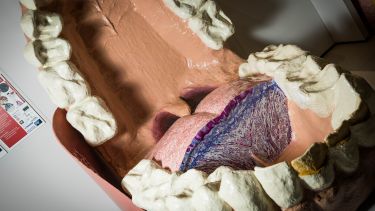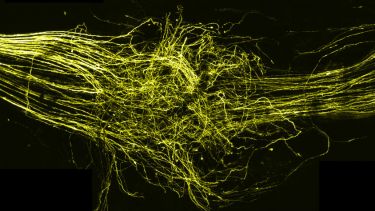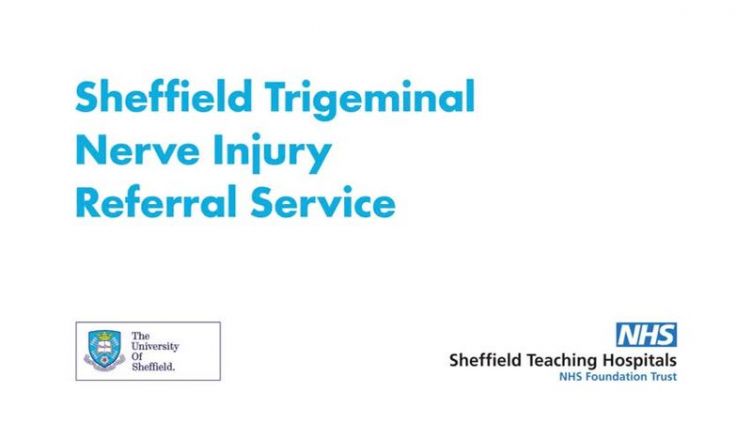Repairing nerves with 3D printing
Imagine spending several hours in surgery only to discover afterwards that you’ve lost feeling in parts of your face or mouth. It’s unlikely but it can happen. Researchers at our School of Clinical Dentistry are using a unique library of human tissue to greatly improve patient outcomes.
The trigeminal nerve connects the brain and parts of the face and mouth, and it's unlikely to be damaged during dental surgery, but that doesn't make it any less distressing. Damage can cause a range of symptoms from complete numbness to abnormal sensations, including tingling or burning in the tongue, lip or chin. Some patients will experience unimaginable pain, whilst others have none.
And the damage isn’t just physical. Patients who experience trigeminal nerve injury report severe quality of life issues. Numbness and pain in the affected areas can impact the ability to eat and speak, causing feelings of anxiety in patients about how they appear to the rest of the world. This can lead to depression, isolation and damaged personal relationships. All from a visit to the dentist. Prior to the research in Sheffield little was offered to these patients in terms of treatment options or potential outcomes.
When neuroscience researchers and oral surgeons at the University of Sheffield’s School of Clinical Dentistry began developing treatments it was understood that, in some circumstances, the nerve could be repaired, but the results were highly variable. “Surgical outcomes were very poor leaving many patients with permanent life altering injuries for which little treatment was offered,” says Dr Simon Atkins, a Senior Clinical Lecturer and Consultant Oral Surgeon at the University of Sheffield, who leads the clinical repair service at Sheffield.
The neuroscience research team built a knowledge base from pre-clinical models designed to mimic the conditions treated in patients. Using this knowledge the research team were able to establish a technique for repairing the nerve by removing damaged tissue and stitching the remaining nerve endings together. This technique produced better overall recovery than repair with either a nerve or muscle graft and proved a success in patients with moderate damage. But for some the area of damage was too large for the nerve ends to be rejoined.
Simon, along with Professor Fiona Boissonade and Dr Emma Bird, both from the School of Clinical Dentistry, are now researching ways to repair these more challenging nerves. “We’re working with the Professors Frederik Claeyssens and John Haycock from the Department of Material Science and Engineering to develop biocompatible materials that can be used to bridge larger gaps between nerve ends,” explains Fiona. Their solution? 3D printing. “We use 3D printing to accurately create a tubular structure out of the biocompatible material. By 3D printing we can add features to the ‘tube’ that help to guide and enhance new growth of nerve fibres.”
That still leaves the question of why some patients experience pain but not others – and how to more effectively target pain in those who do feel it. “The pain patients feel ranges from slight tingling or burning to sharp stabbing pains, all of which can be devastating and have major impacts on their quality of life,” says Emma. Simon, Fiona and Emma are now using a unique archive of human tissue consisting of injured portions of the nerve removed at the time of nerve repair. Crucially, each sample is linked with a detailed pain history for the patient it's come from, including the presence and intensity of pain. It’s this history that’s providing new insight into the possible causes of pain. “The idea is to generate potential new treatments to reduce pain in those who experience it,” says Fiona. “We’re advancing our research, looking into how relevant molecules in and around the nerves might be influencing the amount of pain patients experience.”
Establishing a national tertiary referral centre
Simon, Fiona and Emma’s work on trigeminal nerve repair is a stand-out example of internationally leading ‘bench to bedside’ interdisciplinary research and evidence of the vision for the Neuroscience Institute at the University of Sheffield.
Their research has led to the establishment of a national tertiary referral centre for patients with trigeminal nerve injury. This has had a major impact on practice and the treatment that patients from throughout the UK receive, with greatly improved outcomes showing highly significant improvements in sensation and reductions in pain.
Our research in nerve repair provides a great example of how basic neuroscience research can be translated to the clinic to improve patient treatment and quality of life
Fiona Boissonade
Professor of Oral Neuroscience
That research is making a difference. More than 20 years of work has gone into repairing the trigeminal nerve to improve patients’ quality of life to develop the national tertiary centre. The University of Sheffield School of Clinical Dentistry is now a world-leader in this field and the only known institute in the country capable of such successful trigeminal nerve repair.
By Alicia Shephard
Relevant publications
Additive manufactured biodegradable poly(glycerol sebacate methacrylate) nerve guidance conduits.
Mannose-6-phosphate facilitates early peripheral nerve regeneration in thy-1-YFP-H mice
Funders
Engineering and Physical Sciences Research Council
Renovo Group plc
Research profiles
For more information please contact:
Amy Huxtable
Media Relations Officer
University of Sheffield
0114 222 9859
a.l.huxtable@sheffield.ac.uk



